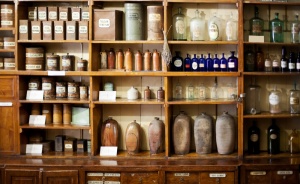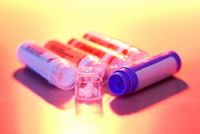Homeopathy
| See Also | Naturopathic Therapies |
|---|
In the 1800s, Samuel Hahnemann (1755 – 1843), a German physician who was disenchanted with the medical system of his day, believed that there were better and safer ways of restoring health. Through observation and experimentation he founded Homeopathy. In 1825 Homeopathy was brought to the US by Dr. Hans Burch Gram (1787 – 1840). In 1833 Dr. Constantine Hering (1800 – 1880) immigrated to America and later became known as the father of American homeopathy.[1]
The term "homeopathy" means ‘like cures like’. Homeopathy was based on the belief that the curative power of medicines stemmed from their ability to induce in healthy persons symptoms analogous to the diseases for which they were administered. Hahnemann and his followers, subscribed to the vitalistic approach to medicine, believing that a spirit-like force was present in every organism and that sickness was due to an alteration of the vital force."Simply put, the purpose of using a homeopathic medicine is to stimulate the body and mind to heal itself on all levels, and regain biological and psychological balance. It does this through the use of uniquely prepared remedies, prescribed to match the precise symptom complex expressed by a person who is ill." Asa Hershoff, ND
| Article | Homeopathy Meets Naturopathy, NDNR; 2013 February |
|---|
Contents
Classification
Homeopathic remedies are typically classified based on their original source.
- Primary Sources
- Herbal remedies constitute a large majority of the homeopathics available.
- Mineral remedies are typically deep-acting remedies.
- Animal remedies includes such things as snake or spider remedies.
- Secondary Sources
- Nosodes refer to remedies made from bacteria or other diseased materials.
- Non-material refers to remedies made from energy sources such as light or electricity.
Homeopathic Concepts
Homeopathy is known for many different concepts including:[2], [3]
- Law of Similars
- Vital Force
- Minute Dosages
- Individualized Treatment
- Supportive versus Suppressive Treatments
- Symptom Modalities
Remedy Preparation
The preparation of homeopathic remedies starts with the original substance (whether it be animal, plant or mineral or nosode or non-material) extracted in some fashion. Plants sources, for example, are generally fresh and are extracted using alcohol to make a mother tincture; minerals or metals are ground down with milk sugar as the diluting agent to make them into soluble triturations.
The next stage involves a potentization phase when the solution goes through a series of dilutions typically with alcohol, either in the ratio of 1:9 or 1:99. Once diluted the the preparation is shaken vigorously, known as succession. Substances that have undergone these successive steps are termed potencies or dilutions.
The potentized remedies are then put into a carrier substance (usually sugar pellets but sometimes tablets, tiny granules, or liquid) and packaged in impervious bottles or tubes. [4]
Case Taking
The central diagnostic tool in Homeopathy is the case taking. It is during this process that a patient is encouraged through an extensive questionning process to discuss not only the symptoms that they are experiencing, but the impact of those symptoms on their life, their ability to conduct their daily activities and on their mental health. It is not unusual for a full case to take to 1 to 3 hours in length. During the case taking the role of the patient is to talk, the role of the doctor is to observe and listen.
A thorough case taking will explore the symptoms modalities in detail. When describing a symptom or condition the more information that is received the better. For example, if pain or discomfort was a concern a naturopathic doctor or homeopathic practitioner would want to know the quality, intensity and nature of the symptom. For example, they would ask about whether the symptoms were sharp, radiating, aching, if there was any tenderness, the impact of pressure, the consistency of the discomfort, the sensations (stiffness, tightness, constriction, numbness, burning, heaviness, weakness, etc.), signs of swelling, restlessness or any discharge, the location of the discomfort, any associated symptoms, the chronology and past history, and what the patient believed to be the cause.
Therapeutic Styles
Prescribing Considerations
Homeopathy is based on the concept of individualized treatment. The results of the case taking is used to determine the appropriate remedy and the prescribed frequency and potency.
Remedy Choice
Finding a remedy picture that matches the symptom picture of the patient is the crux of homeopathy. There is typically no single remedy that matches every symptom; likewise a person will seldom have every symptom that is common with a particular remedy. Symptoms are not of equal value but exist in a hierarchy based on clarity, intensity and peculiarity of the symptoms.
Once the key symptoms have been determined, a homeopathic materia medica is used to summarize the symptoms. A homeopathic repertory is then used like a dictionary which correlates the symptoms to the remedies.
Potency and Dosage
Symptoms and illnesses can occur on the psychological, functional, structural or spiritual levels. Different potencies are designed to work at different levels. Typically the lower the potency the more it works on the functional and structural levels; the higher the potency the more it tends to work on the psychological and spiritual levels.
The frequency of the dose depends on the severity of the condition, the actual potency, and the remedy itself. Some remedies are short-acting and require frequent repetition, while others rarely need it even in acute illness. It is common in acute conditions that a remedy be taken frequently. In chronic conditions, lower potencies are often taken daily and higher potencies are often taken monthly or infrequently.
Considerations
Homeopathic remedies are a form of energy medicine and hence can be antidoted in various ways, depending on many factors including: [5]
- Light: can disrupt the energy pattern of the remedy. Prolonged exposure to bright sunlight or strong fluorescent lights can "zap" remedies.
- Heat: especially is strong heat, can neutralize remedies.
- Odours: opening a remedy in the presence of strong perfumes, moth balls, incense or aromatic oils can impact a remedy.
- Camphor: has a general antidotal effect on many remedies. Camphor is found in various liniments, "tiger balm", and camphorated ointments.
- Magnetic fields: such as metal detectors and close proximity to computers, televisions screens, clock radios, and other electrical devices can neutralize remedies.
- X-ray: exposure can impact remedies. This includes the type commonly used in airports.
- Storage: Keep remedies in a dark place at room temperatures or in their own filing card box. Do not store in refrigerators, spice cabinets, with herbs, near chemicals and cleansers, or near any other strong-smelling substances.
- Lifestyle: Foods and other lifestyle factors that are known to aggravate a condition should be avoided while taking remedies.
- External: Different traumas, surgeries, mediciations and life events can antidote a remedy.
Research
| Article | Clinical Pearls--Case Studies: Homeopathy in End-Stage Illness, Vital Link; 2007 Spring/Summer |
|---|
| Article | Homeopathy for Autistic Spectrum Disorder, NDNR; 2012 November |
|---|
Homeopathy is an energy medicine system. The challenge with most current research techniques are that they are not designed to evaluate this form of medicine. Yet even still, there is a growing body of research that supports the use of homeopathy. [6]
- One of the ways to analyze Homeopathic effectiveness is Krillion photography.
References
- ↑ Kirchfield Friedhelm & Boyle Wade 1994 Nature Doctors: Pioneers in Naturopathic Medicine NCNM Press, Portland Oregon
- ↑ Hershoff Asa 2000 Homeopathic Remedies, A Quick and Easy Guide to Common Disorders and their Homeopathic Treatments Avery Publishing Group, New York
- ↑ Ullman Robert and Reichenberg-Ullman Judyth 1997 Homeopathic Self-Care, The Quick and Easy Guide for the Whole Family Prima Publishing, California
- ↑ Hershoff Asa 2000 Homeopathic Remedies, A Quick and Easy Guide to Common Disorders and their Homeopathic Treatments Avery Publishing Group, New York
- ↑ Hershoff Asa 2000 Homeopathic Remedies, A Quick and Easy Guide to Common Disorders and their Homeopathic Treatments Avery Publishing Group, New York
- ↑ Kleijnan J, Knipschild P, ter Riet G. Clinical Trials of Homeopathy, British Medical Journal 302 Feburary 9,1991:316-323.

